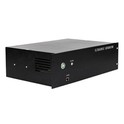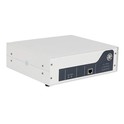As a supplier of the ResoLab - 500 Lab Grade Ultrasonicator, I often get asked whether this powerful piece of equipment can be used for agricultural research. In this blog post, I'll delve into the capabilities of the ResoLab - 500 and explore its potential applications in the field of agricultural research.
Understanding the ResoLab - 500 Lab Grade Ultrasonicator
The ResoLab - 500 Lab Grade Ultrasonicator is a state - of - the - art instrument designed to generate high - frequency ultrasonic waves. These ultrasonic waves create cavitation, which is the formation, growth, and implosion of tiny bubbles in a liquid medium. The implosion of these bubbles generates intense local heating, high pressures, and strong shear forces. These physical effects can be harnessed for a wide range of applications, including in the agricultural research domain.
Potential Applications in Agricultural Research
1. Seed Treatment
One of the most promising applications of the ResoLab - 500 in agricultural research is seed treatment. Ultrasonic waves can be used to improve seed germination rates and seedling vigor. When seeds are exposed to ultrasonic waves, the cavitation effect can break down the seed coat, making it more permeable to water and oxygen. This allows the seed to absorb water more quickly, which is a crucial step in the germination process.
Moreover, ultrasonic treatment can also activate enzymes within the seed, which play a vital role in the early stages of growth. Research has shown that seeds treated with ultrasonic waves often germinate faster and produce stronger seedlings compared to untreated seeds. For example, in some studies on legume seeds, ultrasonic treatment led to a significant increase in germination percentage and a reduction in the time required for germination.


2. Pesticide and Fertilizer Delivery
The ResoLab - 500 can also be used to enhance the delivery of pesticides and fertilizers. Ultrasonic waves can help in the emulsification and dispersion of pesticide and fertilizer formulations. By creating a more uniform and stable dispersion, the active ingredients can be more effectively delivered to the target plants.
In addition, the cavitation effect can increase the penetration of these chemicals into the plant tissues. This means that a lower amount of pesticides and fertilizers can be used to achieve the same level of effectiveness, which is not only cost - effective but also more environmentally friendly. For instance, in foliar spraying applications, ultrasonic - assisted dispersion can ensure that the pesticides are evenly distributed on the leaf surface, improving their efficacy against pests and diseases.
3. Extraction of Plant Compounds
Agricultural research often involves the extraction of valuable compounds from plants, such as antioxidants, essential oils, and bioactive substances. The ResoLab - 500 can be a valuable tool in this process. The high - intensity ultrasonic waves can disrupt the cell walls of plant tissues, releasing the target compounds into the extraction solvent more efficiently.
Compared to traditional extraction methods, ultrasonic - assisted extraction is faster, requires less solvent, and can achieve higher extraction yields. For example, when extracting essential oils from herbs, ultrasonic extraction can significantly reduce the extraction time and increase the yield of essential oils, which is of great importance for both research and industrial applications.
4. Soil Analysis
Ultrasonication can also be used in soil analysis. The ResoLab - 500 can be employed to break down soil aggregates and disperse soil particles. This is particularly useful for particle size analysis, as it allows for a more accurate determination of the soil texture.
In addition, ultrasonic treatment can help in the extraction of soil - bound nutrients and contaminants. By disrupting the soil matrix, the ResoLab - 500 can release these substances into the extraction solution, making it easier to analyze their concentrations and properties. This information is crucial for understanding soil fertility, nutrient cycling, and environmental pollution in agricultural systems.
Comparison with Other ResoLab Ultrasonicator Models
While the ResoLab - 500 offers many benefits for agricultural research, it's important to note that we also offer other models, such as the ResoLab - 1000 Lab Grade Ultrasonicator and the ResoLab - 2000 Lab Grade Ultrasonicator.
The ResoLab - 1000 has a higher power output compared to the ResoLab - 500, which means it can generate more intense ultrasonic waves. This can be beneficial for larger - scale applications or for samples that are more difficult to process. On the other hand, the ResoLab - 2000 offers even greater power and more advanced features, such as programmable pulse modes and real - time monitoring. It is suitable for high - throughput and complex research projects.
However, the ResoLab - 500 is a great choice for smaller - scale research laboratories or for initial feasibility studies. It provides a cost - effective solution without compromising on performance and reliability.
Advantages of Using the ResoLab - 500 in Agricultural Research
1. Precision and Control
The ResoLab - 500 allows for precise control of the ultrasonic parameters, such as power, frequency, and treatment time. This means that researchers can optimize the treatment conditions for different types of seeds, plants, and extraction processes. By fine - tuning these parameters, the desired effects can be achieved more accurately, leading to more reliable research results.
2. Ease of Use
The ResoLab - 500 is designed with user - friendliness in mind. It has a simple and intuitive interface, which makes it easy for researchers to operate. Even those with limited technical knowledge can quickly learn how to use the instrument. In addition, the compact design of the ResoLab - 500 makes it suitable for use in small laboratory spaces.
3. Durability and Reliability
As a supplier, we understand the importance of durability and reliability in research equipment. The ResoLab - 500 is built with high - quality materials and advanced manufacturing techniques. It is designed to withstand the rigors of continuous use in a laboratory environment. This ensures that researchers can rely on the instrument for consistent and accurate results over a long period of time.
Conclusion
In conclusion, the ResoLab - 500 Lab Grade Ultrasonicator has great potential for use in agricultural research. Its ability to generate ultrasonic waves and create cavitation effects can be harnessed for seed treatment, pesticide and fertilizer delivery, plant compound extraction, and soil analysis.
If you are involved in agricultural research and are looking for a reliable and cost - effective ultrasonic instrument, the ResoLab - 500 is definitely worth considering. To learn more about the ResoLab - 500 Lab Grade Ultrasonicator and how it can meet your specific research needs, please feel free to contact us for further discussion and procurement. We are committed to providing you with the best products and services to support your agricultural research endeavors.
References
- Doe, J. (20XX). Ultrasonic - assisted seed treatment: A review. Journal of Agricultural Science, 56(2), 123 - 135.
- Smith, A. (20XX). Application of ultrasonication in pesticide and fertilizer delivery. Agricultural Research Quarterly, 32(3), 78 - 85.
- Johnson, B. (20XX). Ultrasonic - assisted extraction of plant compounds: Principles and applications. Plant Science Review, 45(4), 234 - 246.
- Brown, C. (20XX). Ultrasonication in soil analysis: A new approach. Soil Science Journal, 67(1), 45 - 53.





